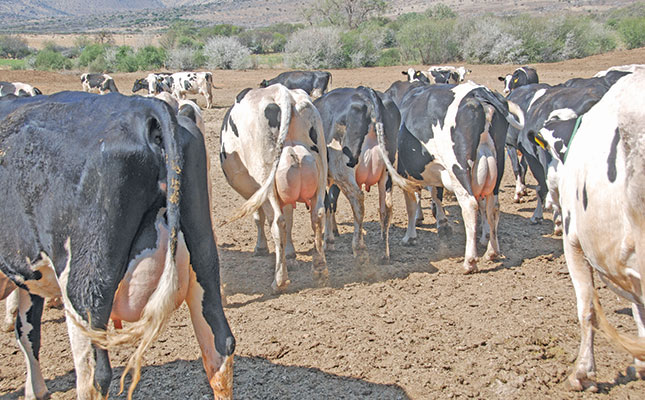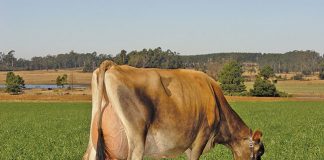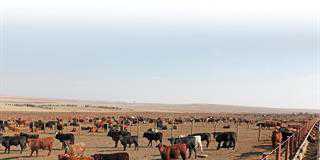
Photo: FW Archive
Bovine mastitis (inflammation of the udder) can be caused by numerous factors, including bacterial infection and trauma, and can lead to abnormal and decreased milk production. It remains one of the most common problems plaguing the dairy industry today.
The treatment of clinical cases of mastitis is not only expensive for dairy farmers, who must carry higher labour and treatment costs while simultaneously discarding milk, but also increases the risk of antibiotic residue in bulk tanks.
The condition can also adversely affect the reproductive performance of dairy cows. Cows that have had mastitis usually take significantly longer to conceive. Mastitis is one of the main reasons that dairy producers cull their cows.
Aside from the pain that mastitis-stricken cows have to endure, even mild cases can have an effect on milk quality due to an increase in inflammatory (somatic) cells in the milk.
“More severe cases can have a dramatic impact on milk production, and extremely severe cases can result in death.
“Traditionally, there has been a high level of reliance on antibiotics for the treatment and prevention of mastitis,” says Dr Chantelle Erwee, technical manager of the ruminants division at animal health company Zoetis South Africa.
“The possible fatal consequences and general cost of treating mastitis warrant an appropriate mastitis prevention and control programme.”
| Causes and effects of bovine mastitis
Bovine mastitis is inflammation of the mammary gland or udder caused by trauma or infection. The most common pathogen responsible is the bacterium Staphylococcus aureus; however, Streptococcus uberis, S. dysgalactiae, S. agalactiae, as well as Enterococcus and coliform bacteria, are all significant. Cows can contract these pathogens via direct contact during the milking process, or from their environment. There are various forms of mastitis. In subclinical mastitis, the milk appears normal, and there is no visible sign of inflammation of the udder. Diagnosis is based on an increase in the somatic cell count (SCC) in milk. With clinical mastitis, the cow may present with fever and/or depression. There may also be evidence of udder inflammation. Physical changes in the milk, such as clots and clumps of fibrin, may also be apparent. Acute mastitis presents with fever, depression, and a loss of appetite. The cow’s udder may appear swollen, and may be hard to the touch. The milk from a cow with acute mastitis may contain clots or flakes, or may be watery, serous or purulent. Cows with acute gangrenous mastitis present with anorexia, dehydration, depression, fever, and toxaemia, which may lead to death. The udder is red, swollen and warm to the touch. Secretions are watery and bloody, and the udder eventually becomes necrotic. Chronic mastitis may present with clinical signs from time to time. However, there may not be any clinical signs for prolonged intervals. The milk may occasionally contain clots, flakes or shreds of fibrin. The SCC will be elevated. Source: zoetisus.com |
Unpacking the myths of mastitis
“The dry period is crucial and can affect the occurrence of clinical mastitis in the lactation that follows,” explains Erwee.
“Studies have estimated that 52% to 60% of clinical mastitis cases that occurred in early lactation actually originated in the dry period. These infections usually remain dormant until the first three months of lactation, when they cause clinical and subclinical mastitis.”
While the cost of treating mastitis itself is not high, there are many hidden costs that can add up. These include lactational yield loss, which has been calculated at an average of 375kg/lactation after a case of clinical mastitis. Milk discarded due to the withdrawal period of medications used can also have a lasting impact on costs, and there are always potential losses through deaths.
“A South African study published in 2016 found the total cost of mastitis per cow per year to be almost R2 000. This will be higher today,” says Erwee.
A common way in which pathogens gain access to the udder is via the teat canal.
“Soon after drying off, a keratin plug forms in the teat canal as part of the cow’s natural defence mechanisms. This plug prevents access to the mammary gland by physically blocking the entrance of mastitis-causing pathogens. The rate at which the plug forms differs from cow to cow. For example, [high-yielding cows] tend to have delayed closure. If there is any delay in the formation of this plug, cows are at higher risk of developing mastitis caused by an environmental pathogen.”
Teat sealants were developed in response to this problem, and have proved an effective solution, mimicking the physical barrier function of the natural keratin plug.
Studies performed in the UK, Australia, New Zealand, the US and Canada have shown that the use of internal teat sealants during the dry period can effectively prevent or reduce new intramammary infections and clinical mastitis in the lactation to come.
“A combination of internal teat sealants and dry cow antibiotic therapy is used around the world in places like Australia, North America, Europe and New Zealand.
“However, this is regarded as a relatively new concept in South Africa, which is something we’re actively working towards changing,” says Erwee.
Focusing on prevention
The control of mastitis is based on a sound management programme that should include at least some of the following practices:
- Proper use of a functional milking machine, as well as appropriate milking machine maintenance;
- Effective disinfection of teats, before and after milking, with an approved teat dip;
- Early treatment of clinical cases of mastitis;
- Dry cow therapy, if appropriate, at the end of lactation, using a dry cow antibiotic mastitis treatment product;
- Use of internal teat sealants;
- The culling of cows with chronic mastitis; and
- Appropriate vaccination with a Gram-negative core-antigen vaccine to reduce coliform infections.
“Prevention is always better than cure,” advises Erwee. “A good preventative mastitis management programme not only protects the health and well-being of dairy cows, but helps to keep milk production stable, limit the use of antibiotics, and maintain the quality of milk.”
| The California Milk Cell Test
The California Milk Cell Test (CMCT), also known as the California Mastitis Test, is a cow-side indicator of the somatic cell count (SCC) in a milk sample. It makes use of a four-well plastic paddle and a reagent. Before conducting the test, clean the cow’s udder to remove manure and other dirt, which could contaminate the sample. Once the udder is cleaned, draw foremilk from each quarter and discard. Next, place the CMCT paddle under the cow’s udder, and draw equal amounts of milk into the wells, each of which represents one quarter of the udder. The wells should only be about one-third full. Pour off any excess milk from the paddle to ensure an equal sample in each well. Pour the diluted reagent into each well; the volume used in each should be equal to that of the milk sample. Swirl the paddle to mix the reagent and milk. The reaction is rapid, so the test should be read quickly. The more gel-like the milk becomes, the more severe the infection. If the milk does not thicken, the cow is not infected and receives a score of 0 (SCC of lower than 200 000 cells/ml). If there is a slight thickening of the milk, which disappears quickly and returns to liquid when poured out, the cow receives a T (trace) score, or a score of 1 (SCC of lower than 1,2 million cells/ml). This means that she may be positive. If two or more quadrants are affected, she is considered positive for subclinical mastitis. If there is noticeable thickening of the liquid, which remains thick and viscous even when poured, the cow receives a score of 2 or 3 (SCC of higher than 1,2 million cells/ml), which is an indication of severe mastitis. Source: Penn State Extension. |
Visit zoetis.co.za.










